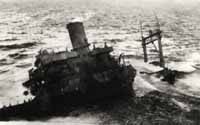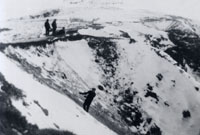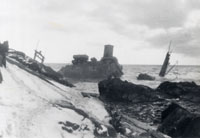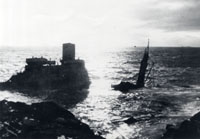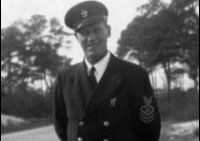Chapter 6: The Story – Dead Reckoning
Abandon Ship! – The Pollux
Back onboard the Pollux, the sailors watched with mounting horror as their vessel began to break up beneath them. Cracks in the hull widened and new ones appeared with disturbing regularity. At about 10:30 a US Navy plane flew overhead and the Wilkes, which was watching the Pollux from a distance of about 1,000 yards, signalled the aircraft to send help. The flagship also tried floating liferafts to the Pollux, but these were all swept away by the strong ocean current. There was little the Wilkes could do but watch and wait.
Suddenly, the front part of the Pollux broke away entirely. It was just before noon. A wave of panic swept through the sailors as the ship tilted to one side and water gushed into the starboard (right) side. No one knew how much longer the ship would stay in that position – powerful waves were still battering the vessel and threatening to dislodge it from its rocky nest. Commander Turney saw no alternative: he permitted all willing sailors to abandon ship.
In the chaos that followed, more than 100 men slid down the lifelines and cargo nets hanging over the side of the ship and plunged into the churning waters below. It was a horrible mistake. The violent waters dashed dozens of men against the rocky cliffs and swept others out to sea or sucked them under the congealed oil. The lifejackets also caused problems – many men did not fasten the ties below their chins and when they hit the water, their lifejackets rode up over their faces and jammed their arms straight over their heads. Many men died in place like that – their heads trapped underwater, their arms reaching straight up, and their lifeless bodies bobbing around in the waves and debris.
The men onboard the Pollux watched helplessly as their shipmates died around them. Above the roar of the sea and the creaking of the vessel, they could hear drowning men screaming for their mothers or warning their friends to stay out of the water. George Coleman later described what he saw in those nightmarish moments: “I believe I was more stunned and bewildered to see what was happening and just couldn't believe what was going on. I don't know how long I was standing there by the lifeline looking down in that raging sea when I raised my eyes and looked towards the beach and I saw one sailor making his way to the beach, and then he may have been about 12 to 15 feet from the beach. I saw him turn around, face the ship, give a hand salute, and I saw him go down.” (Tape 10, 10:44-11:31)
On shore, Lloyd and Calemmo tried to pull in any swimmer who came within reach of their cave. “Lloyd and I by this time were in the surf again pulling men out of the muck,” Calemmo said of that morning. “These men could not help themselves. I was very exhausted and half froze myself. While lying on my stomach, I would lock my hand on [the man's] upper arm, ask the guy to do the same to me. I would then try to pull him out. If the man didn't budge, I would say: ‘Let go. I can't get you out.’ The poor soul would cry: ‘Try again, Larry, try again. You know me – help me! Don't leave me here.’” (Tape 38, 17:34-18:08)
The two men pulled about eight sailors from the oil and water that day, and about 20 more made it to the plateau where Garnaus, Greenfield, and DeRosa had climbed to safety. But more than 80 others died within minutes of entering the water. Dumbfounded and grief-stricken, Turney forbade any other man from abandoning ship. They would have to find another way to reach shore.
Lawn
The small fishing town of Lawn lay about 10 miles away from the Pollux at Lawn Point. The villagers had learned about the Truxtun through the telephone switchboard that connected them with St. Lawrence, but no one yet knew anything about the Pollux. Then, at around midday, a local youth named Adolph Jarvis and a man named Joseph Manning reported that they had seen a second vessel aground at Lawn Point. Could it be true? Could there be a second warship in trouble that morning? It seemed almost impossible to believe.
Some of the men wondered if they should mount a rescue party. Lawn Point was much closer to St. Lawrence than it was to Lawn. In order for the villagers to reach it, they would have to walk for about five or six hours through thick woods and over tall hills. By the time they got there, everyone suspected the men would have already been rescued by the people from St. Lawrence. But what if they weren't?
In the end a group of eight men from Lawn set out on the long trek to the Pollux. They were: Thomas Connors, James Drake, Andrew Edwards, Martin Edwards, Alfred Grant, Robert Jarvis, Jim Manning, and Joseph Manning. These men brought with them some rope, axes, flashlights, and five horses. Although they suspected that they would have to spend the night at Lawn Point if it became too dark to walk home, they did not anticipate the desperate scene that would greet them upon their arrival that evening.
